2014 年 4 月全国高等教育自学考试英语阅读二真题
课程代码:00596
请考生按规定用笔将所有试题的答案涂、写在答题纸上。全部题目用英文作答(翻译题
除外)。
选择题部分
注意事项:
1. 答题前,考生务必将自己的考试课程名称、姓名、准考证号用黑色字迹的签字笔或
钢笔填写在答题纸规定的位置上。
2. 每小题选出答案后,用 2 B 铅笔把答题纸上对应题目的答案标号涂黑。如需改动,
用橡皮擦干净后,再选涂其他答案标号。不能答在试题卷上。
I. Reading Comprehension (50 points,2 points for each)
Directions: In this part of the test, there are five passages. Following each
passage, there are five questions with four choices marked A, B,C and D. Choose the
best answer and then blacken the corresponding letter on your Answer Sheet.
Passage One
Social anxiety is the single most common psychological problem, according to
the 1986 results of the Stanford shyness inventory, a survey conducted by Philip
G.Zimbardo, a professor of social psychology at Stanford University in California.
At a party with strangers, for instance, three-quarters of adults feel anxious. “The
best estimate is that 40 percent of all Americans suffer from shyness,” says
Zimbardo.
How can you avoid being nervous when you meet people? Prepare. Preparation for
any communication situation is a must. You’ve been invited to a big dinner party
in two weeks. You know that one of the other guests is a politician. Scan the
newspapers and magazines; listen to newscasts for topics of conversation in
political areas. Then at the party, pretend you’re an interviewer on talk show.
Think of questions to ask what can’t be answered yes or no. “In your opinion,
who...”“What do you think of...” Keep the momentum going.
Whether you’re delivering a speech, approaching your boss for a raise or an
important social occasion, do your homework. The most polished, smoothly delivered,
spontaneous-sounding talks are the result of many hours of work. The memorable
one-liners and moving phrases that go down in history don’t come from last-minute
�
bursts of inspiration.
If you’re making a presentation of any sort, begin preparing as far ahead of
time as possible.“Good writing,”says Harvard University historian Richard Marius,
“is a kind of wrestling with thought.” Begin the wrestling match early. Two days
before your presentation is usually too late to go into the ring and come up with
a winning idea.
“To communicate,” says New York Times columnist William Safire, “put your
thoughts in order, give them a purpose; use them to persuade, to instruct, to discover,
to seduce.”
Prepare yourself as well as your material, giving special attention to your voice.
A shrill, nasal tone strikes your listeners like chalk screeching on a blackboard.
By putting energy and resonance into your voice, you will have a positive effect.
If your voice is timid or quivers with nervousness, you sense it, the audience hears
it, and you see discomfort in their eyes. With energy and enthusiasm in your voice
the listeners say ahhh, tell me more. You read approval.
Like your voice, your appearance is a communication tool. For example, if you
are animated, you are most likely to see animated listeners. You give the audience
the message: I’m glad I’m here; I’m glad you’re here.
Your approach can, in fact, be a powerful weapon for deflecting hostility-from
an audience, an interviewer, an employer. A benevolent aspect says I understand and
conveys good will and positive expectations. It works.
Questions l-5 are based on Passage One.
1. According to paragraph 2, one can avoid shyness while talking to a politician
at a party by ______.
A. listening to his talk B. reading newspapers to him
C. preparing in a advance D. asking him hard questions
2. In paragraph 3 the author suggests that we do our homework for an important
social occasion because ______.
A. only careful preparation can make our talks polished
B.homework can help us learn from our own mistakes
C. we need inspiration for memorable and moving talks
�
D. it is necessary to avoid harsh criticism from the supervisors
3. Based on paragraph 4, when should you begin the preparation for a
presentation?
A. Two days ahead of time. B. As early as possible.
C. When you are clearheaded. D. When you are not busy.
4. According to paragraph 6, what kind of voice is likely to win the audience’
s approval?
A. A nasal tone. B. A shrill tone.
C. A quivering tone. D. An energetic tone.
5. What is the author’s attitude toward overcoming nervousness?
A. Critical. B. Negative.
C. Suspicious. D. Positive.
Passage Two
How many languages do you speak? One, maybe, two, you say? Wrong! If you speak
English, you use words from at least 3 5 foreign languages. Surprised?
You shouldn’t be. Tim Morris is an English professor at the University of Texas,
Arlinton. He says that when we speak English, we are using bits and pieces of many
languages. Scholars estimate that one-third of the world ’ s languages are of
Indo-European origin. These include English, French, Latin, German, Dutch, Celtic,
and Slavic tongues. Back around AD 450, when Julius Caesar was alive, English as
we know didn’t exist. English is relatively young. Its roots go back l,500 years
to Britain. People there spoke Celtic. Then came Anglo-Saxon invaders.“These
conquerors spoke languages closely related to older forms of Dutch.” Morris says.
Dutch words like “woord”, “gas” and “man”, became the English equivalents
“word”, “grass” and “man”. Anglo-Saxon “Anglish” became “English”.
But our story doesn’t end there. English continued to grow and change. When
Norman French invaded Britain in 1066, the English vocabulary got an enormous boost.
Scholars say that nearly half of all English words are French in their origin. Words
like art, orange, taxi, tree and surprise are a few examples. When English colonists
came to America in the 1700s, they encountered native Americans and their languages.
Words like wigwam, teepee, chipmunk, possum, and tomahawk settled into the
�
colonists’ vocabulary.
Centuries later, in the early 1900s, immigrants streamed to America’s shores.
Italians taught us to say broccoli, macaroni, opera, and studio. Spanish speakers
added mosquito, mustang, tortilloa, and alligator. Bagel, kosher, and pastrami came
from those who spoke Yiddish. And yam, gorilla, and jitterbug were taken from African
languages.
It’s impossible to say exactly how big the English language is. Even counting
all the words in a dictionary won’t give you an accurate figure. But you may be
interested to know that college-size editions like Merriam-Webster ’ s 10th
Collegiate contain about 90,000 “headwords”. Headwords are main entries in bold
print. Under a headword are plurals and various forms of that word, along with
definitions. In a large dictionary, like the Oxford English Dictionary, are more
than 250,000 headwords. Some say the true number of English words is twice of that.
That’s a lot of words! But even a highly educated person uses only about 10% of
them.
Questions 6-10 are based on Passage Two.
6. From the passage we know that ______.
A. English belongs to Sino-Tibetan family
B. English belongs to Indo-European family
C. English was spoken by people before AD 450
D. English was spoken by the Anglo-Saxon invaders
7. According to the passage, the origin of English can be dated back to ______.
A. the late 1700s B. the year 1066
C. the early 1900s D. 1,500 years ago
8. Of the following words, ______ is of Yiddish origin.
A. kosher B. tortilloa
C. possum D. woord
9. A large dictionary, like the Oxford English Dictionary, ______.
�
A. tells the true number of English words
B.gives 250,000 headwords without definition
C. fails to tell the true number of English words
D. fails to give the plural or singular form of headwords
10. Which of the following statements is TRUE?
A. In the mid-1900s, Italian immigrants streamed to America.
B.It’s quite common to come across an Italian word in English.
C. One-third of English words are borrowed from other languages.
D. Native American languages failed to exert any influence on English.
Passage Three
The estimates of the number of home-schooled children vary widely. The U.S.
Department of Education estimates there are 250,000 to 350,000 home-schooled
children in the country. Home-school advocates put the number much higher at about
a million.
Many public school advocates take a harsh attitude toward home schoolers,
perceiving their actions as the ultimate slap in the face for public education and
damaging move for the children. Home schoolers harbor few kind words for public
schools, charging shortcomings that range from lack of religious perspective in the
curriculum to a herdlike approach to teach children.
Yet, as public school officials realize they stand little to gain by remaining
hostile to the home-school population, and as home schoolers realize they can reap
benefits from public schools, these hard lines seem to be softening a bit. Public
schools and home schoolers have moved closer to tolerance and, in some cases, even
cooperation.
John Marshall, an education official, says, “ We are becoming relatively
tolerant of home schoolers.” The idea is, “Let’s give the kids access to public
school so they’ll see it’s not as terrible as they’ve been told, and they’ll
want to come back.”
Perhaps, but don’t count on it, say home-school advocates. Home schoolers oppose
the system because they have strong convictions that their approach to
education-whether fueled by religious enthusiasm or the individual child ’ s
�
interests and natural pace—is best.
“The bulk of home schoolers just want to be left alone,” says Enge Cannon,
associate director of the National Center for Home Education. She says,“Home
schoolers choose that path for a variety of reasons, but religion plays a role 85
percent of the time.”
Professor Van Galen breaks home schoolers into two groups. Some home schoolers
want their children to learn not only traditional subject matter but also “strict
religious doctrine and a conservative political and social perspective. Not
incidentally, they also want their children to learn-both intellectually and
emotionally-that the family is the most important institution in society.”
Other home schoolers contend “not so much that the schools teach heresy(异
端邪说), but that schools teach whatever they teach inappropriately,” Van Galen
writes.“These parents are highly independent and strive to take responsibility for
their own lives within a society that they define as bureaucratic and inefficient.”
Questions 11-15 are based on Passage Three.
11. According to the passage, home schoolers are ______.
A. those who advocate combining public education with home schooling
B. those who are educated at home by their parents instead of going to school
C. those who educate their children at home instead of sending them to school
D. those who engage private teachers to provide additional education for their
children
12. Public schools are softening their position on home schooling because
______.
A. there isn’t much they can do to change the present situation
B.public schools cannot offer proper education for all children
C. they want to show their tolerance of different teaching systems
D.home schooling provides a new variety of education for children
13. Home-school advocates are of the opinion that ______.
�
A. things in public schools are not so bad as has often been said
B. their cooperation with public schools will improve public education
C. home schooling is superior and, therefore, they will not easily give in
D. their tolerance of public education will attract more kids to public schools
14. Most home schoolers’opposition to public education stems from their ______.
A. devotion to religion
B.concern with the cost involved
C. respect for the interests of individuals
D. worry about the inefficiency of public schools
15. According to Van Galen, some home schoolers believe that ______.
A. public schools take a herdlike approach to teach children
B.teachers in public schools are not as responsible as they should be
C. public schools are the source of bureaucracy and inefficiency in modem society
D. public schools cannot provide an education that is good enough for their
children
Passage Four
What will people use the Internet for? Shopping and banking will be big growth
areas. Henley predicts that, from under 1% of all purchases today, it will account
for 6.4% of purchases within four years, amounting to 42 billion. Sales have already
started with dry goods such as books and CDs and, as people learn to trust it, will
move on to regular purchases such as food. Iceland, the supermarket chain, began
computer shopping trials two weeks ago and has already signed up at least 15,000
customers, ranging from busy executives to the housebound. When it links up with
digital television, Iceland expects to double that immediately.
Yet internet-linked televisions and phones may be only the start. One potential
breakthrough is Bluetooth named after a 10th century Danish king famed for his rotten
front tooth and uniting warring factions in Denmark and Norway.
The modern Bluetooth allows an unlikely array of machines to talk to each other,
�
so that a phone tucked away in a briefcase can remember to send out a signal that
turns on a video machine 50 miles away, switches on the heating or starts the cooker.
Cars, offices and kitchens will all speak to each other. In Finland, the idea of
phones communicating with computerized tills so that you press a button and pay for
your supermarket goods or drink from a vending machine is being tested.Said one
enthusiast:“Your phone will be your remote control for life.”
As with all revolutions, there are reservations. Health concerns about mobile
phones are unresolved, with microwave radiation linked to increased tiredness and
headaches in one recent study in Sweden.
Some argue that more sophisticated entertainment at home will deepen antisocial
“cocooning” trends, that internet grocery deliveries will kill off the last comer
shops, and that a “couch potato” generation of children will grow even more
over-fat.
The most significant impact, however, will be in the way we work. Adrian Hosford,
director of millennial projects at BT, predicts it will encourage more people to
work at home. “People have talked about telecommuting for years, but at last it
makes economic sense. Many offices will turn into touchdown centers, where people
will only occasionally call in. This is already the case for one in five at BT,”
he said.
Questions 16-20 are based on Passage Four.
16. According to the passage, internet purchases ______.
A. will have great growth in dry goods
B.will be accepted by more and more people
C. will be used in Iceland, the supermarket chain
D. will become a major form of purchase within four years
17. What do we know about Bluetooth?
A. It is a talking software.
B.It is named after a Danish king.
C. It is widely used in internet purchases.
D. It is a remote controller to turn on your phone.
�
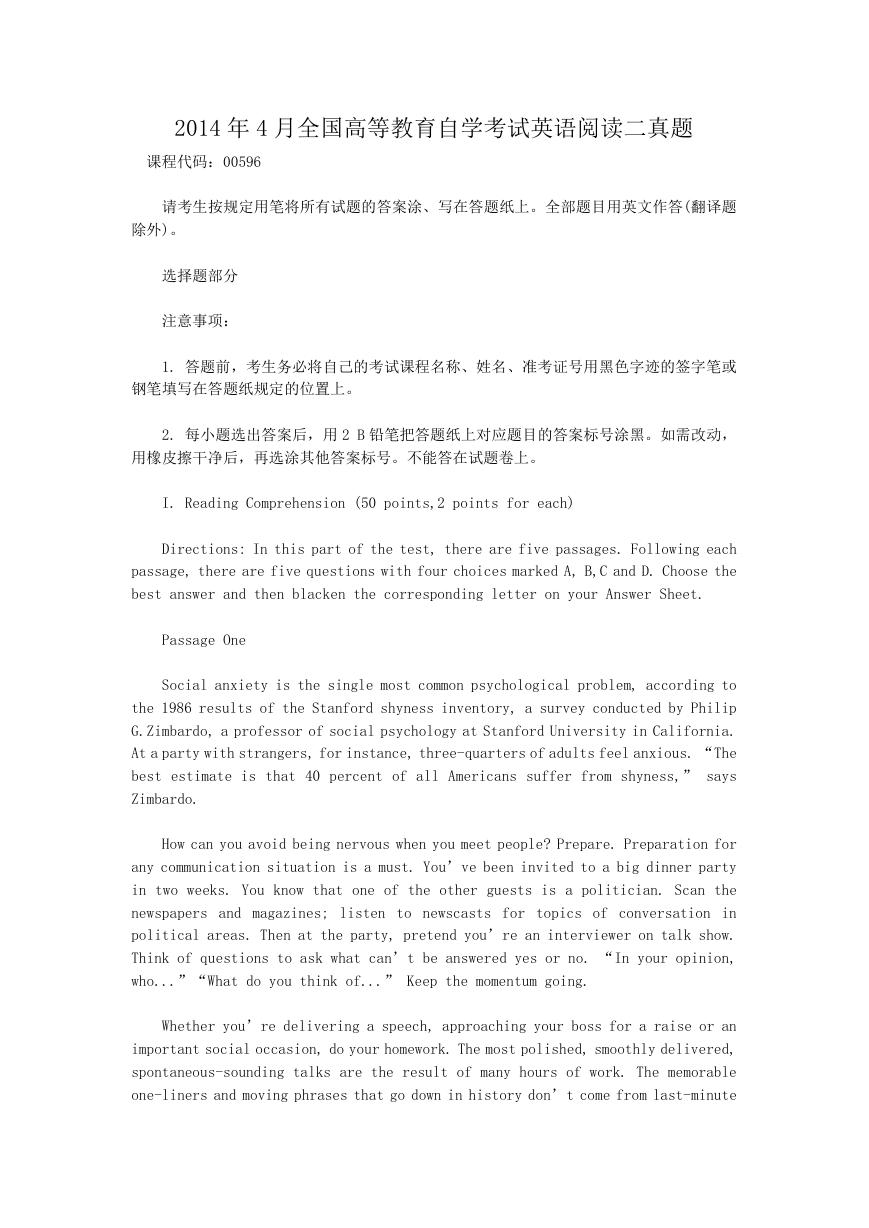
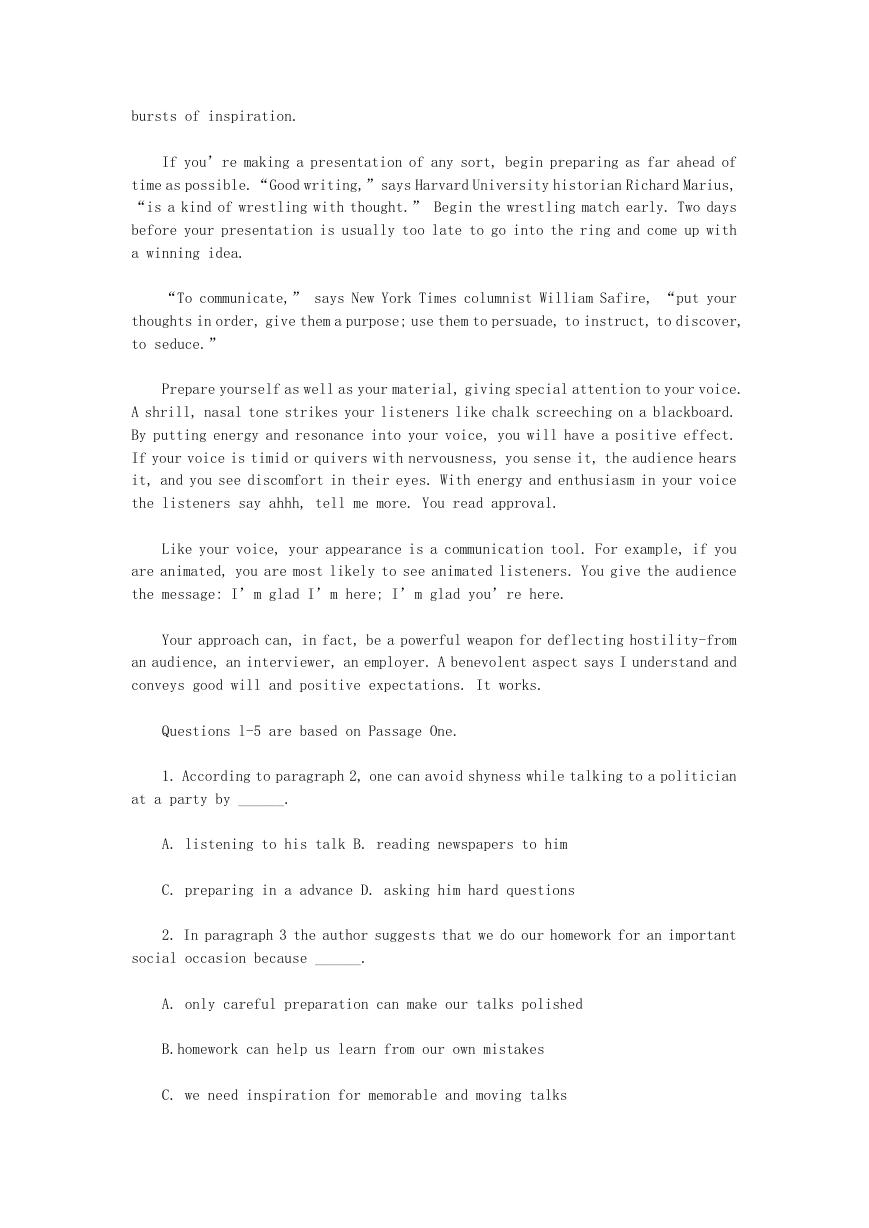
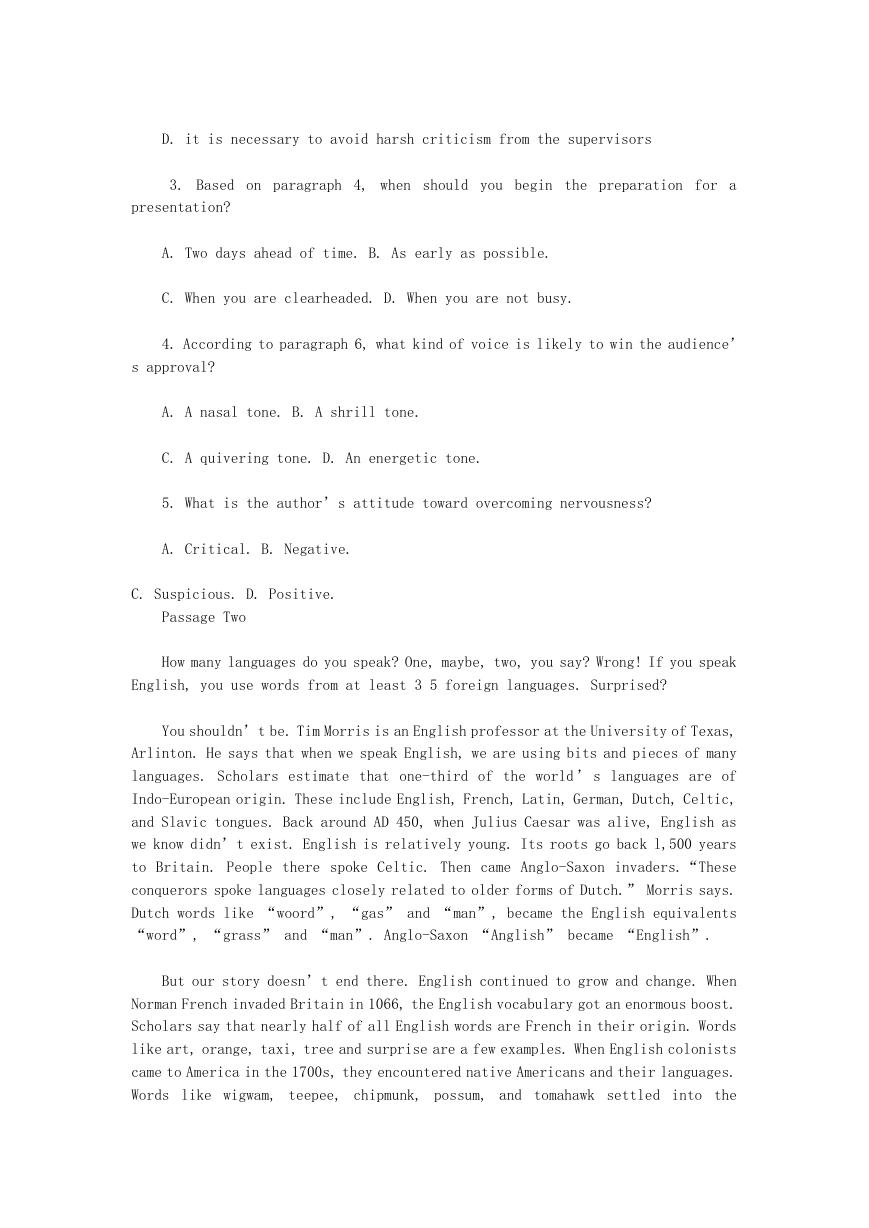


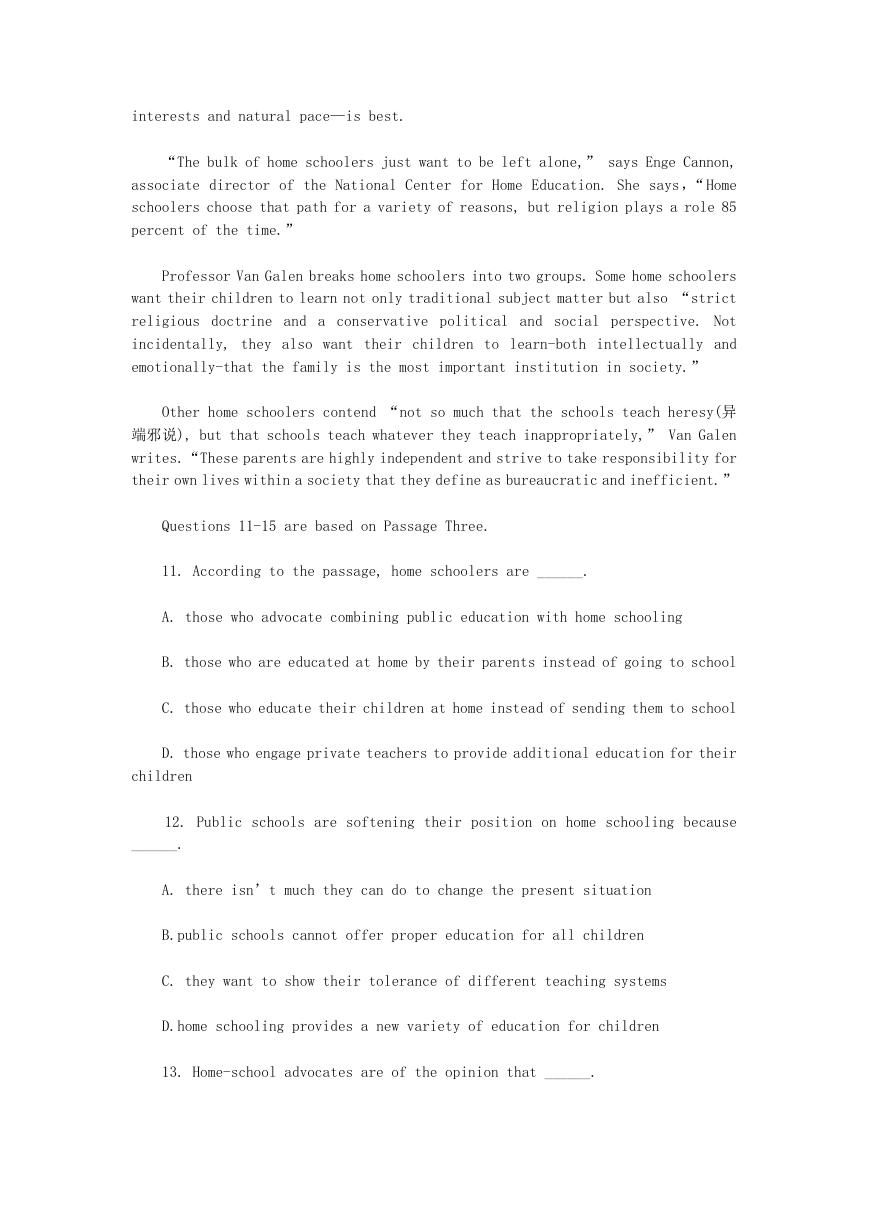
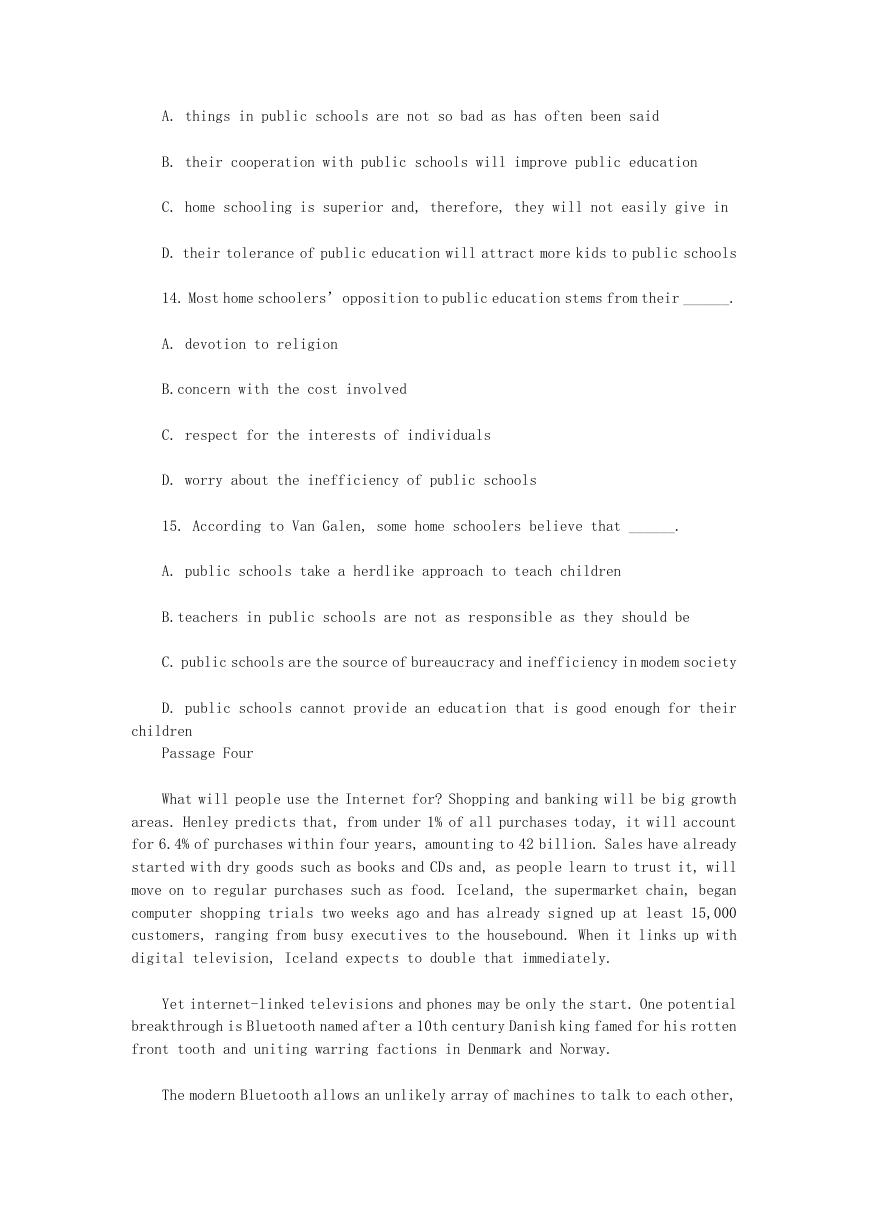
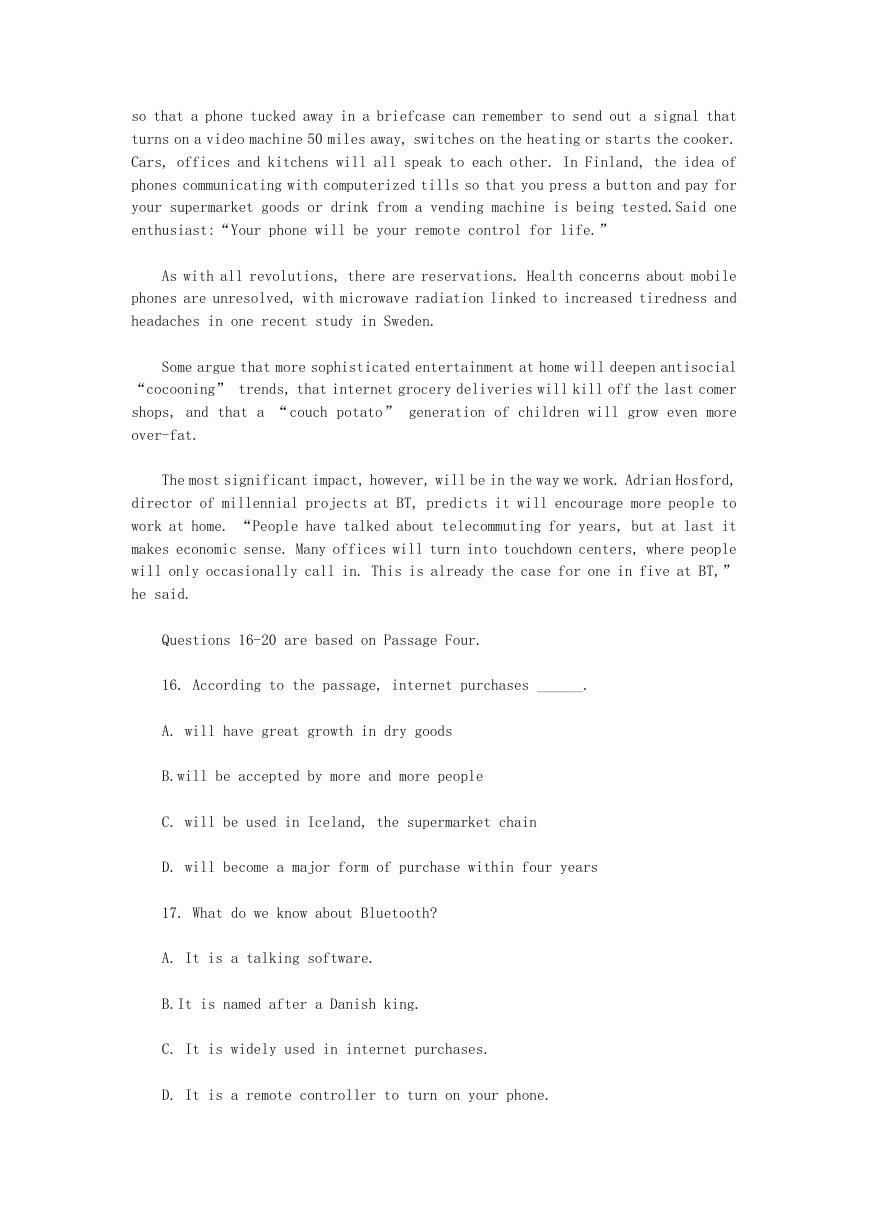








 2023年江西萍乡中考道德与法治真题及答案.doc
2023年江西萍乡中考道德与法治真题及答案.doc 2012年重庆南川中考生物真题及答案.doc
2012年重庆南川中考生物真题及答案.doc 2013年江西师范大学地理学综合及文艺理论基础考研真题.doc
2013年江西师范大学地理学综合及文艺理论基础考研真题.doc 2020年四川甘孜小升初语文真题及答案I卷.doc
2020年四川甘孜小升初语文真题及答案I卷.doc 2020年注册岩土工程师专业基础考试真题及答案.doc
2020年注册岩土工程师专业基础考试真题及答案.doc 2023-2024学年福建省厦门市九年级上学期数学月考试题及答案.doc
2023-2024学年福建省厦门市九年级上学期数学月考试题及答案.doc 2021-2022学年辽宁省沈阳市大东区九年级上学期语文期末试题及答案.doc
2021-2022学年辽宁省沈阳市大东区九年级上学期语文期末试题及答案.doc 2022-2023学年北京东城区初三第一学期物理期末试卷及答案.doc
2022-2023学年北京东城区初三第一学期物理期末试卷及答案.doc 2018上半年江西教师资格初中地理学科知识与教学能力真题及答案.doc
2018上半年江西教师资格初中地理学科知识与教学能力真题及答案.doc 2012年河北国家公务员申论考试真题及答案-省级.doc
2012年河北国家公务员申论考试真题及答案-省级.doc 2020-2021学年江苏省扬州市江都区邵樊片九年级上学期数学第一次质量检测试题及答案.doc
2020-2021学年江苏省扬州市江都区邵樊片九年级上学期数学第一次质量检测试题及答案.doc 2022下半年黑龙江教师资格证中学综合素质真题及答案.doc
2022下半年黑龙江教师资格证中学综合素质真题及答案.doc